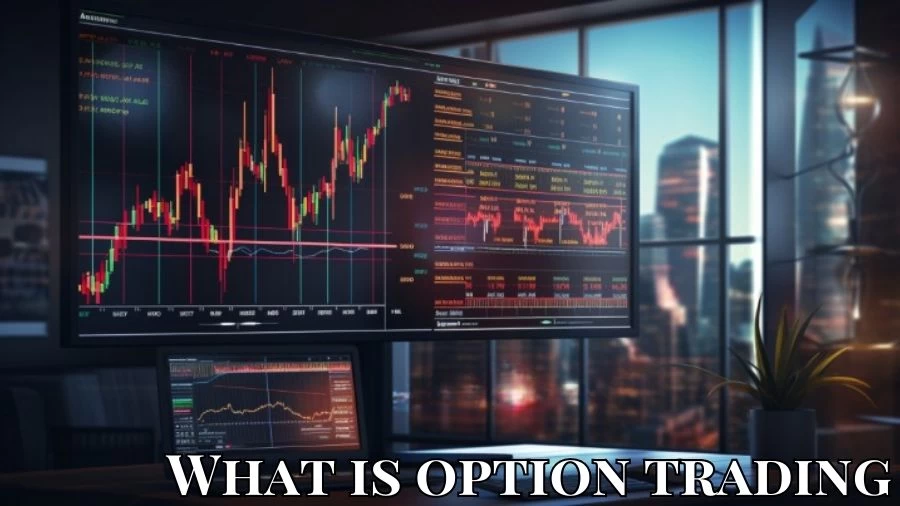
What is Option Trading and How It Works?
Option trading allows investors to buy or sell contracts for underlying securities at set prices, offering speculation on stock performance without the need to own assets.
by Kowsalya
Published Aug 22, 2023 | Updated Aug 22, 2023 | 📖 9 min read
On This Page
- What is Option Trading?
- How Option Trading Works?
- What is Delta in Options Trading?
- What is Binary Options Trading?
- What is Stock Options Trading?
- What is Level 3 Options Trading?
- What Are the Types of Options?
- What is Volume in Options Trading?
- What is Option Trading With Example?
- What Are the Pros and Cons of Option Trading?
What is Option Trading?
Options trading involves the buying or selling of options contracts, which are agreements conferring the choice to purchase or sell a group of underlying securities at a predetermined price by a specific date. These contracts enable investors to engage without the obligation of owning the underlying security.
The process entails two parties: the holder (buyer) and the writer (seller). Holders buy contracts, while writers create them. Holders pay writers a premium for the right to buy or sell a stock by a set date. This premium, often a fee per share, represents the maximum potential loss if the contract expires without value.
Options trading's allure lies in its capacity for investors to speculate on stock performance without risking more than their initial investment. However, the strategies within options trading can be intricate, accompanied by rules, risks, and exceptions. Achieving success demands a firm grasp of options terminology, jargon, and essential concepts. Additionally, traders often need to demonstrate their competence through an agreement with their broker before embarking on options trading.
How Option Trading Works?
Engaging in options trading essentially involves making predictions about a stock's future value movement whether it will rise, fall, or remain stable along with the extent of that change and the timeframe for these shifts.
Based on these predictions, you can opt to enter a contract for buying or selling a company's stock. Calls and puts are the fundamental contract types, referred to by options traders.
Once you've entered a contract, there are several paths to follow: exercising your right to buy or sell, reselling the contract to someone else, or allowing the contract to expire without value. To sum up:
Holders buy contracts, giving them the option to sell or buy the underlying stock before the contract's expiration. Accurate predictions can lead to significant gains, while a worthless contract results in limited losses.
Sellers, also known as writers, profit from the premiums they charge buyers. However, they're obligated to sell or buy the underlying stock at the strike price if the market goes against them, potentially leading to unlimited losses.
Unlike stocks, options trades have defined contract durations, leaving no room for time to see if the trade will eventually move as desired. Thus, options investors must possess a certain level of confidence and market knowledge to make well-informed decisions.
What is Delta in Options Trading?
Delta serves as a risk measure that gauges how a derivative, like an options contract, will change in value with a $1 shift in its underlying security's price. It's denoted as Δ and also guides options traders in achieving delta neutrality for hedging. Additionally, an option's delta signifies the likelihood of ending in-the-money. Delta values can be positive or negative based on the option type.
Delta quantifies the impact of an underlying security's price change on a derivative's value. It ranges from 0 to 1 for call options and from -1 to 0 for put options, determining their sensitivity to price shifts. Delta spread is an options strategy aiming for delta neutrality, involving simultaneous buying and selling of options proportionally. A popular approach is using a calendar spread, constructing a delta-neutral position with options having differing expiration dates.
What is Binary Options Trading?
Binary options are financial instruments offering two potential outcomes upon contract expiration: a predetermined fixed amount or nothing at all, leaving no room for other settlement scenarios. The name "binary" reflects this duality.
These options revolve around a basic question: Will an underlying asset's price surpass a certain level at a specified time? Traders decide based on their belief in a "yes" or "no" response, making binary options one of the most straightforward assets to trade.
This uncomplicated nature has garnered significant attention from both experienced traders and newcomers to the financial markets. Binary options are available for trading on global exchanges and through over-the-counter (OTC) channels, with the United States being among the active markets.
What is Stock Options Trading?
Stock options trading falls under the category of derivatives, financial instruments whose value is derived from an underlying asset's value. In the context of stock options, this asset comprises company shares.
The option itself is a contractual agreement between two parties, offering the option to buy or sell the stock at a predetermined price in the future a price referred to as the strike or exercise price. Stock options are primarily of two types: Call options grant the holder the right (not the obligation) to purchase the asset at a specified price within a defined time window.
Conversely, put options grant the holder the right (not the obligation) to sell the asset at a predetermined price within a specific timeframe. This dual structure enables investors to maneuver within the stock market with flexibility and strategic foresight.
What is Level 3 Options Trading?
Level 3 options trading is an advanced tier within options trading that empowers traders to engage in sophisticated strategies like spreads, iron condors, and iron butterflies. These strategies involve multiple positions and intricate combinations, demanding a comprehensive understanding of option mechanics and a substantial capital base for effective implementation. The progression to level 3 signifies a trader's readiness to delve into complex market maneuvers.
At this level, traders gain the privilege of utilizing margin, a form of borrowed funds from their brokerage, to facilitate their trades. This increased access to capital allows them to craft intricate trades that maximize potential returns while managing risk. Spreads, for instance, involve simultaneously buying and selling options with different strike prices or expiration dates to capitalize on price differentials and mitigate exposure.
Level 3 options trading is not for the novice; it requires a solid grasp of market dynamics, a strategic mindset, and a willingness to accept higher levels of risk due to the intricacies involved. The mastery of this level demonstrates a trader's commitment to navigating the complexities of the financial markets and leveraging advanced strategies to optimize their trading outcomes.
What Are the Types of Options?
Call Options: A call option provides the holder with the choice, though not the obligation, to purchase the underlying security at the predetermined strike price by or on the expiration date. This type of option gains greater value as the underlying security's price increases (calls have a positive delta).
Employing a long call is a method to speculate on the upward movement of the underlying asset's price. This approach offers limitless potential for profit, while the maximum potential loss is limited to the premium paid for the option.
Put Options: In contrast to call options, a put option grants the holder the right, without obligation, to sell the underlying stock at the strike price on or before the expiration date. Consequently, a long put positions the holder in a short stance on the underlying security, as the put's worth appreciates with the decline in the underlying's price (they exhibit a negative delta).
Protective puts can be acquired as a form of safeguard, akin to insurance, offering a safeguarded lower limit for investors to mitigate risk and safeguard their positions. This strategy becomes especially valuable in a declining market scenario.
What is Volume in Options Trading?
In the context of options trading, volume refers to the count of option contracts that have been traded within a specified timeframe. Analyzing the daily trading volume provides valuable insights into the intensity of ongoing price fluctuations, along with gauging investor demand and the availability of liquidity. Essentially, it serves as a technical indicator reflecting the current level of market interest.
Nonetheless, it's important to recognize that trading volume is a relative measure and should be considered in a broader time context to gain a comprehensive understanding of trader engagement and liquidity dynamics. Additionally, a meaningful assessment can be made by comparing the trading volume to the average daily volume of the underlying stock. By examining this data, traders and analysts can make more informed decisions regarding market trends and potential opportunities.
What is Option Trading With Example?
Imagine Microsoft (MSFT) stocks are trading at $108 per share, and you anticipate their value will rise. To capitalize on this, you buy a call option, essentially granting you the right to benefit from potential stock price growth. You acquire one call option for $115 strike price, expiring in a month, paying 37 cents per contract—totaling $37 including fees (0.37 x 100 = $37).
If the stock climbs to $116, your option's value becomes $1. This is because you can exercise it, purchasing shares at $115 and selling them immediately at $116, generating a profit. This gain of $1 from an initial 37 cents equates to a remarkable 170.3% profit, surpassing the 7.4% rise in the stock from $108 to $116.
In terms of dollars, your net profit amounts to 63 cents or $63 since each option contract is equivalent to 100 shares [($1 - 0.37) x 100 = $63].
Conversely, if the stock drops to $100, your option expires without value, costing you the $37 premium. The positive aspect is that you avoided buying 100 shares at $108, which would have led to an $800 loss ($8 per share). This highlights how options can mitigate potential losses, underscoring their risk-controlling potential.
What Are the Pros and Cons of Option Trading?
Advantages:
- Call option purchasers can acquire assets at a reduced rate compared to the market, particularly when stock prices surge.
- Put option buyers can profit by selling stocks at the predetermined strike price if the market price is lower than that.
- Option sellers gain a premium fee from buyers in exchange for writing an option.
Disadvantages:
- Put option sellers might need to purchase assets at a higher strike price than usual if the market experiences a decline.
- Call option writers face potentially boundless risk if stock prices surge, obliging them to buy shares at elevated prices.
- Option buyers are required to make an initial premium payment to option writers.
What is Option Trading-FAQs
1. What is options trading?
Options trading involves buying or selling options contracts, which grant the choice to purchase or sell underlying securities at a predetermined price within a specified timeframe.
2. How do options contracts work?
Options contracts consist of two parties: the holder (buyer) and the writer (seller). Holders pay writers a premium for the right to buy or sell a stock at a set price by a certain date
3. Why is options trading appealing to investors?
Options trading allows investors to speculate on stock performance without risking more than their initial investment.
4. Are options trading strategies complex?
Yes, options trading strategies can be intricate and involve various rules, risks, and exceptions.
5. Is prior agreement or competence required for options trading?
Yes, many brokers may require traders to demonstrate their competence and understanding of options trading through agreements or assessments before allowing them to participate.




